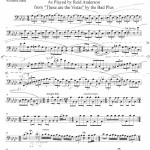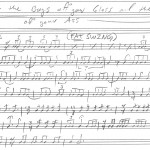 (Ethan Iverson, Reid Anderson and David King – courtesy of bighassle.com)
(Ethan Iverson, Reid Anderson and David King – courtesy of bighassle.com)
Keep the Bugs off your Glass and the Bears off your Ass, written by David King and performed by: The Bad Plus (Reid Anderson, Acoustic Bass; Ethan Iverson, Piano; and David King, Drums). From the album ‘These are the Vistas,’ released 2003 by Columbia Records.
Audio clip: Adobe Flash Player (version 9 or above) is required to play this audio clip. Download the latest version here. You also need to have JavaScript enabled in your browser.
Download the PDF: Bass Clef, Treble Clef, Bb, Eb
Anyway, this track is fantastic, and there’s nothing like a killer unaccompanied bass solo to get my dancing in my chair while making a serious jazz face*. Since this solo is unaccompanied Anderson has the freedom to do whatever he wants, and he does not squander this opportunity to stretch out. The most interesting aspects of this solo, imo, are the amazing syncopated rhythms and quirky cadenza-style phrasing.
I’ve indicated important cadences with double bar lines and the well-defined subphrases with phrase slurs (on handwritten analysis only). There are also two phrase extensions (mm. 10-11, 14-15) marked by dotted lines, and in both cases they’re short interludes between primary and secondary cadences (landing on a low F natural). The cadences in mm. 11 and 15 also begin the next phrase, which weakens them. Also, the cadence at m. 15 lands on the 2nd triplet of beat 1 which makes it very difficult to keep ones metric bearings while listening casually. Anderson’s phrases are extremely varied, and one way he accomplishes this is by placing his cadences in a variety of places (m. 11.1, m. 6.3, m. 19.4).
At m. 20 the groove subsides and Reid seems to completely disregard time signature, entering a free flowing cadenza-like texture. I’ve chosen to notate this with changing meters as suggested by his phrasing, although by no means am I implying that these groupings were necessarily his intention as he played, so take the time signatures with a grain of salt.
*In case you don’t know, the jazz face is a scrunching of ones’ facial features in appreciation of something especially musical/awesome/nasty/good. Adam Meckler exemplifies the jazz face, so if you ever see him live, watch him while his fellow performers are soloing. Boom, jazz face.

